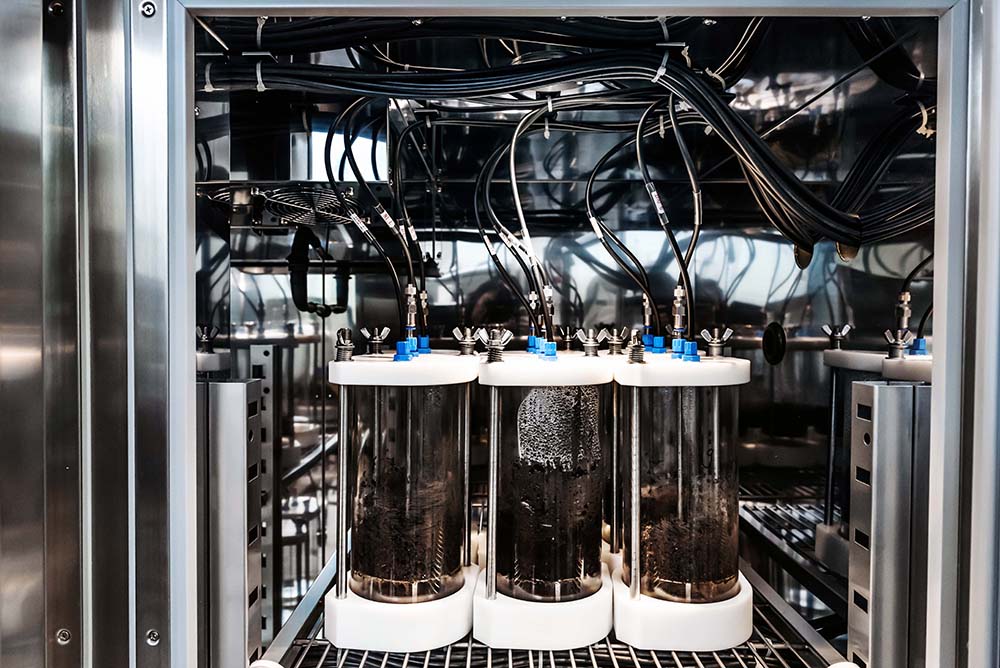The Bioseniatic℠ Laboratory—FAQs

Questions?
Below are answers to the most frequently asked questions we get about our Bioseniatic℠ Laboratory and the services we offer.
If you have more questions after reviewing this page, click here to send us an email.
What is the Bioseniatic™ standard?
A material or product must meet the following criteria to be a Bioseniatic™ material or product:
- Naturally-sourced or synthetically-derived polymers with no additives or chemical modifications to their structure that prevent them from being biologically converted into a non-polymeric form of naturally occurring, non-toxic compounds at a rate congruous with natural analogues.
- The post-consumer product must not promote the formation of intentional or persistent micro- or nanoparticles.
For more information about our Bioseniatic™ criteria, click here.
Is the Bioseniatic℠ Laboratory an ISO certified testing facility?
The laboratory is not an ISO 17025 certified testing body. Data generated from testing is not amenable for certification with the Biodegradable Products Institute (BPI), Din Certo, TÜV Austria, or other certification agencies.
Is data generated from testing suitable for filling IP through the U.S. Patent and Trademark Office?
Yes, all validated data generated from testing is suitable for IP filings through the United States Patent and Trademark Patent Office.
Who owns the data from analytical testing and will it be published?
Data generated from testing is owned by the client or sponsor. The University of Georgia New Materials Institute will not publish any data without written consent from the owner of the testing data.
What are the most common end-of-life tests?
- Respirometry analysis
- Disintegration photography (laboratory and field sites)
- Gravimetric disintegration
- Heavy metal analysis
- Toxicity to plant life (Click here to learn more about our germination studies.)
- Microplastic analysis
Click here for a comprehensive list of our testing and analytical capacity.
What does respirometry measure?
Respirometry quantifies the catabolic metabolism of organic carbon in the sample by measuring the cumulative CO2 generated from the sample.
What is the difference between biodegradable plastics and compostable plastics?
A biodegradable plastic is a degradable plastic in which the degradation results from the action of naturally occurring microorganisms such as bacteria, fungi and algae. A compostable plastic is a plastic that undergoes degradation by biological processes during composting to yield CO2, water, inorganic compounds, and biomass at a rate consistent with other known compostable materials and leaves no visible, distinguishable or toxic residue. The terms biodegradable plastic and compostable plastic are defined in ASTM D6400.
What is carbon mineralization?
Carbon mineralization describes the process whereby organic carbon in a sample is oxidized to CO2 through microbial degradation of the samples.
What is gravimetric disintegration testing?
A plastic product is considered to have demonstrated satisfactory disintegration if after 12 weeks (84 days) in a controlled composting test, no more than 10% of its original dry weight remains after sieving on a 2.0-mm sieve. The test shall be carried out in accordance with ISO 16929 with a minimum vessel volume of 35 L, or ISO 20200 under thermophilic aerobic composting conditions.
Can gravimetric disintegration be used to analyze respirometry testing residues?
What types of tests are utilized by the Bioseniatic℠ Laboratory to analyze samples for microplastics?
We may analyze composting, soil, or ocean sample residues for microplastics larger than about 30 µm using an automated Raman microscope. Any found microplastic particles are targeted with a 780 nm laser and valorized by Raman spectroscopy, providing chemical evidence of particle composition. Please note that not all samples are Raman active and darkly pigmented samples may not be suitable for testing. There is no ISO/ASTM standard for microplastic analysis.
What is the price structure for testing?
Some analytical tests are priced according to the number of samples analyzed, while other tests are priced based on the number of months in the study period and the number of samples to be analyzed.
We quote each project individually. Click here to contact us for a quote on your project. Click here for a comprehensive list of our testing and analytical capacity.
